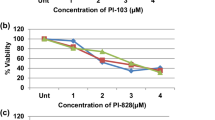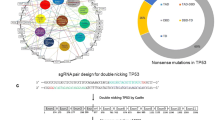Abstract
We recently argued for a major role of p53 in staurosporine(ST)-induced apoptosis of immortalized epithelial cells, depending on their p53 status. Here, we studied the effects of PRIMA-1 (p53 reactivation and induction of massive apoptosis) and Pifithrin-α (p fifty-three inhibitor) in combination with ST to reinforce our previous results by respectively restoring or inhibiting the p53 transcriptional activity in different cell lines.
PRIMA-1 does modify neither expression of apoptosis-related proteins nor the percentage of wild-type p53 HeLa and CaSki cells with ➘ΔΨm and DNA cleavage, whilst it increases by 45% Bax expression and apoptosis of mutated p53 C33A cells. Pifithrin-α, does modify neither Bax expression nor apoptosis level of C33A cells, but readily inhibits both ➘ΔΨm and DNA fragmentation of p53wt cells with decreasing Bax expression. These data support the evidence that PRIMA-1 could be a good candidate, as an anti-cancer drug targeting mutant p53, in order to increase ST efficiency. Moreover, Pifithrin-α could be used in combination with ST and PRIMA-1 to prevent side effects of anti-tumor therapies in cells expressing mutant P53.
Similar content being viewed by others
Abbreviations
- ST:
-
staurosporine
- PFT-α:
-
pifithrin-α
- ΔΨm :
-
mitochondrial membrane potential
- ΔΨm :
-
mitochondrial membrane depolarization
- PBS:
-
phosphate-buffered saline
- wt:
-
wild-type
- mt:
-
mutated
- DBD:
-
DNA binding domain
- HPV:
-
human papillomavirus
References
Lane DP. Cancer. p53, guardian of the genome. Nature 1992; 358(6381): 15–16.
Vogelstein B, Lane D, Levine AJ. Surfing the p53 network. Nature 2000; 408(6810): 307–310.
Lu H, Levine AJ. Human TAFII31 protein is a transcriptional coactivator of the p53 protein. Proc Natl Acad Sci USA 1995; 92(11): 5154–5158.
Olivier M, Eeles R, Hollstein M, Khan MA, Harris CC, Hainaut P. The IARC TP53 database: New online mutation analysis and recommendations to users. Hum Mutat 2002; 19(6): 607–614.
Chene P. Inhibiting the p53-MDM2 interaction: An important target for cancer therapy. Nat Rev Cancer 2003; 3(2): 102–109.
Kessis TD, Slebos RJ, Han SM, et al. p53 gene mutations and MDM2 amplification are uncommon in primary carcinomas of the uterine cervix. Am J Pathol 1993; 143(5): 1398–1405.
Kessis TD, Slebos RJ, Nelson WG, et al. Human papillomavirus 16 E6 expression disrupts the p53-mediated cellular response to DNA damage. Proc Natl Acad Sci USA 1993; 90(9): 3988–3992.
Bykov VJ, Issaeva N, Shilov A, et al. Restoration of the tumor suppressor function to mutant p53 by a low-molecular-weight compound. Nat Med 2002; 8(3): 282–288.
Bykov VJ, Selivanova G, Wiman KG. Small molecules that reactivate mutant p53. Eur J Cancer 2003; 39(13): 1828–1834.
Komarova EA, Chernov MV, Franks R, et al. Transgenic mice with p53-responsive lacZ: p53 activity varies dramatically during normal development and determines radiation and drug sensitivity in vivo. Embo J 1997; 16(6): 1391–1400.
Schwartz D, Goldfinger N, Rotter V. Expression of p53 protein in spermatogenesis is confined to the tetraploid pachytene primary spermatocytes. Oncogene 1993; 8(6): 1487–1494.
Komarov PG, Komarova EA, Kondratov RV, et al. A chemical inhibitor of p53 that protects mice from the side effects of cancer therapy. Science 1999; 285(5434): 1733–1737.
Komarova EA, Gudkov AV. Chemoprotection from p53-dependent apoptosis: Potential clinical applications of the p53 inhibitors. Biochem Pharmacol 2001; 62(6): 657–667.
Komarova EA, Gudkov AV. Suppression of p53: A new approach to overcome side effects of antitumor therapy. Biochemistry (Mosc) 2000; 65(1): 41–48.
Komarova EA, Gudkov AV. Could p53 be a target for therapeutic suppression? Semin Cancer Biol 1998; 8(5): 389–400.
Charlot JF, Pretet JL, Haughey C, Mougin C. Mitochondrial translocation of p53 and mitochondrial membrane potential (Delta Psi m) dissipation are early events in staurosporine-induced apoptosis of wild type and mutated p53 epithelial cells. Apoptosis 2004; 9(3): 333–343.
Henseleit U, Zhang J, Wanner R, Haase I, Kolde G, Rosenbach T. Role of p53 in UVB-induced apoptosis in human HaCaT keratinocytes. J Invest Dermatol 1997; 109(6): 722–727.
Bernard B, Prétet JL, Charlot JF, Mougin C. Human papillomaviruses type 16+ and 18+ cervical carcinoma cells are sensitive to staurosporine-mediated apoptosis. Biol Cell 2003; 95(1): 17–26.
Zaika A, Irwin M, Sansome C, Moll UM. Oncogenes induce and activate endogenous p73 protein. J Biol Chem 2001; 276(14): 11310–11316.
Melino G, Bernassola F, Ranalli M, et al. p73 Induces apoptosis via PUMA transactivation and Bax mitochondrial translocation. J Biol Chem 2004; 279(9): 8076–8083.
Katiyar SK, Roy AM, Baliga MS. Silymarin induces apoptosis primarily through a p53-dependent pathway involving Bcl-2/Bax, cytochrome c release, and caspase activation. Mol Cancer Ther 2005; 4(2): 207–216.
Vander Heiden MG, Thompson CB. Bcl-2 proteins: Regulators of apoptosis or of mitochondrial homeostasis? Nat Cell Biol 1999; 1(8): E209–216.
Takagi-Morishita Y, Yamada N, Sugihara A, Iwasaki T, Tsujimura T, Terada N. Mouse uterine epithelial apoptosis is associated with expression of mitochondrial voltage-dependent anion channels, release of cytochrome c from mitochondria, and the ratio of Bax to Bcl-2 or Bcl-X. Biol Reprod 2003; 68(4): 1178–1184.
Lehman TA, Modali R, Boukamp P, et al. p53 mutations in human immortalized epithelial cell lines. Carcinogenesis 1993; 14(5): 833–839.
Szymanska K, Hainaut P. TP53 and mutations in human cancer. Acta Biochim Pol 2003; 50(1): 231–238.
Soussi T, Beroud C. Significance of TP53 mutations in human cancer: A critical analysis of mutations at CpG dinucleotides. Hum Mutat 2003; 21(3): 192–200.
Crook T, Wrede D, Vousden KH. p53 point mutation in HPV negative human cervical carcinoma cell lines. Oncogene 1991; 6(5): 873–875.
Yeager TR, Reznikoff CA. Methotrexate resistance in human uroepithelial cells with p53 alterations. J Urol 1998; 159(2): 581–585.
Weller M. Predicting response to cancer chemotherapy: The role of p53. Cell Tissue Res 1998; 292(3): 435–445.
Bykov VJ, Wiman KG. Novel cancer therapy by reactivation of the p53 apoptosis pathway. Ann Med 2003; 35(7): 458–465.
Bykov VJ, Issaeva N, Selivanova G, Wiman KG. Mutant p53-dependent growth suppression distinguishes PRIMA-1 from known anticancer drugs: A statistical analysis of information in the National Cancer Institute database. Carcinogenesis 2002; 23(12): 2011–2018.
Syljuasen RG, Sorensen CS, Hansen LT, Stanek J, Bennett WP, Welsh JA, Metcalf RA, Stampfer MR, Fusenig N, Rogan EM, et al. Inhibition of human Chk1 causes increased initiation of DNA replication, phosphorylation of ATR targets, and DNA breakage. Mol Cell Biol 2005; 25(9): 3553–3562.
Zerbini LF, Wang Y, Correa RG, Cho JY, Libermann TA. Blockage of NF-kappaB induces serine 15 phosphorylation of mutant p53 by JNK kinase in prostate cancer cells. Cell Cycle 2005; 4 (9): 1247–1253.
Chan UP, Lee JF, Wang SH, Leung KL, Chen GG. Induction of colon cancer cell death by 7-hydroxystaurosporine (UCN-01) is associated with increased p38 MAPK and decreased Bcl-xL. Anticancer Drugs 2003; 14(9): 761–766.
She QB, Chen N, Dong Z. ERKs and p38 kinase phosphorylate p53 protein at serine 15 in response to UV radiation. J Biol Chem 2000; 275(27): 20444–20449.
Perfettini JL, Castedo M, Nardacci R, et al. Essential role of p53 phosphorylation by p38 MAPK in apoptosis induction by the HIV-1 envelope. J Exp Med 2005; 201(2): 279–289.
Huang C, Ma WY, Maxiner A, Sun Y, Dong Z. p38 kinase mediates UV-induced phosphorylation of p53 protein at serine 389. J Biol Chem 1999; 274(18): 12229–12235.
Bulavin DV, Saito S, Hollander MC, et al. Phosphorylation of human p53 by p38 kinase coordinates N-terminal phosphorylation and apoptosis in response to UV radiation. Embo J 1999; 18(23): 6845–6854.
Adams JM, Cory S. Life-or-death decisions by the Bcl-2 protein family. Trends Biochem Sci 2001; 26(1): 61–66.
Scarlett JL, Sheard PW, Hughes G, Ledgerwood EC, Ku HH, Murphy MP. Changes in mitochondrial membrane potential during staurosporine-induced apoptosis in Jurkat cells. FEBS Lett 2000 475(3): 267–272.
Chipuk JE, Bouchier-Hayes L, Kuwana T, Newmeyer DD, Green DR. PUMA couples the nuclear and cytoplasmic proapoptotic function of p53. Science 2005; 309(5741): 1732–1735.
Leu JI, Dumont P, Hafey M, Murphy ME, George DL. Mitochondrial p53 activates Bak and causes disruption of a Bak-Mcl1 complex. Nat Cell Biol 2004; 6(5): 443–450.
Chipuk JE, Kuwana T, Bouchier-Hayes L, et al. Direct activation of Bax by p53 mediates mitochondrial membrane permeabilization and apoptosis. Science 2004; 303(5660): 1010–1014.
Kuwana T, Bouchier-Hayes L, Chipuk JE, et al. BH3 domains of BH3-only proteins differentially regulate Bax-mediated mitochondrial membrane permeabilization both directly and indirectly. Mol Cell 2005; 17(4): 525–535.
Mihara M, Erster S, Zaika A, et al. p53 has a direct apoptogenic role at the mitochondria. Mol Cell 2003; 11(3): 577–590.
Schuler M, Green DR. Transcription, apoptosis and p53: Catch-22. Trends Genet 2005; 21(3): 182–187.
Park BS, Song YS, et al. Phospho-ser 15-p53 translocates into mitochondria and interacts with Bcl-2 and Bcl-xL in eugenol-induced apoptosis. Apoptosis 2005; 10(1): 193–200.
Erster S, Moll UM. Stress-induced p53 runs a transcription-independent death program. Biochem Biophys Res Commun 2005; 331(3): 843–850.
Zhao Y, Chaiswing L, Velez JM, et al. p53 translocation to mitochondria precedes its nuclear translocation and targets mitochondrial oxidative defense protein-manganese superoxide dismutase. Cancer Res 2005; 65(9): 3745–3750.
Erster S, Moll UM. Stress-induced p53 runs a direct mitochondrial death program: its role in physiologic and pathophysiologic stress responses in vivo. Cell Cycle 2004; 3(12): 1492–1495.
Erster S, Mihara M, Kim RH, Petrenko O, Moll UM. In vivomitochondrial p53 translocation triggers a rapid first wave of cell death in response to DNA damage that can precede p53 target gene activation. Mol Cell Biol 2004; 24(15): 6728–6741.
Pecere T, Sarinella F, Salata C, et al. Involvement of p53 in specific anti-neuroectodermal tumor activity of aloe-emodin. Int J Cancer 2003; 106(6): 836–847.
Vukicevic V, Kampfinger K, Stopper H. Influence of altered apoptosis in human lymphoblastoid cell lines on micronucleus frequency. Toxicol Lett 2004; 147(2): 187–195.
Li Y, Jenkins CW, Nichols MA, Xiong Y. Cell cycle expression and p53 regulation of the cyclin-dependent kinase inhibitor p21. Oncogene 1994; 9(8): 2261–2268.
Haldar S, Negrini M, Monne M, Sabbioni S, Croce CM. Down-regulation of bcl-2 by p53 in breast cancer cells. Cancer Res 1994; 54(8): 2095–2097.
Selvakumaran M, Lin HK, Miyashita T, et al. Immediate early up-regulation of bax expression by p53 but not TGF beta 1: A paradigm for distinct apoptotic pathways. Oncogene 1994; 9(6): 1791–1798.
Wu Y, Mehew JW, Heckman CA, Arcinas M, Boxer LM. Negative regulation of bcl-2 expression by p53 in hematopoietic cells. Oncogene 2001; 20(2): 240–251.
Komarova EA, Neznanov N, Komarov PG, Chernov MV, Wang K, Gudkov AV. p53 inhibitor pifithrin alpha can suppress heat shock and glucocorticoid signaling pathways. J Biol Chem 2003; 278(18): 15465–15468.
Murphy PJ, Galigniana MD, Morishima Y, et al. Pifithrin-alpha inhibits p53 signaling after interaction of the tumor suppressor protein with hsp90 and its nuclear translocation. J Biol Chem 2004; 279(29): 30195–30201.
Kelly KJ, Plotkin Z, Vulgamott SL, Dagher PC. P53 mediates the apoptotic response to GTP depletion after renal ischemia-reperfusion: Protective role of a p53 inhibitor. J Am Soc Nephrol 2003; 14(1): 128–138.
Gerl R, Vaux DL. Apoptosis in the development and treatment of cancer. Carcinogenesis 2005; 26(2): 263–270.
Kaufmann SH, Vaux DL. Alterations in the apoptotic machinery and their potential role in anticancer drug resistance. Oncogene 2003; 22(47): 7414–7430.
Zhang M, Liu W, Ding D, Salvi R. Pifithrin-alpha suppresses p53 and protects cochlear and vestibular hair cells from cisplatin-induced apoptosis. Neuroscience 2003; 120(1): 191–205.
Rehman A, Chahal MS, Tang X, Bruce JE, Pommier Y, Daoud SS. Proteomic identification of heat shock protein 90 as a candidate target for p53 mutation reactivation by PRIMA-1 in breast cancer cells. Breast Cancer Res 2005; 7(5): R765–774.
Chipuk JE, Maurer U, Green DR, Schuler M. Pharmacologic activation of p53 elicits Bax-dependent apoptosis in the absence of transcription. Cancer Cell 2003; 4(5): 371–381.
Issaeva N, Bozko P, Enge M, et al. Small molecule RITA binds to p53, blocks p53-HDM-2 interaction and activates p53 function in tumors. Nat Med 2004; 10(12): 1321–1328.
Author information
Authors and Affiliations
Corresponding author
Rights and permissions
About this article
Cite this article
Charlot, J.F., Nicolier, M., Prétet, J.L. et al. Modulation of p53 transcriptional activity by PRIMA-1 and Pifithrin-α on staurosporine-induced apoptosis of wild-type and mutated p53 epithelial cells. Apoptosis 11, 813–827 (2006). https://doi.org/10.1007/s10495-006-5876-6
Published:
Issue Date:
DOI: https://doi.org/10.1007/s10495-006-5876-6




